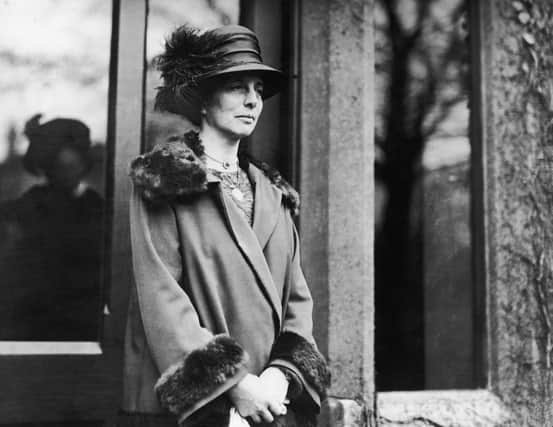What today's politicians could learn from the remarkable Kitty - Susan Morrison


But this was no window-smashing, sash-wearing, force-fed survivor of the suffragette wars. This was a woman who had actively campaigned against women’s right to vote, then changed her mind and ran for parliament. This Kitty thought for herself, defying attempts to pigeon-hole her into ideological boxes. They nicknamed her “The Red Duchess”.
She was born in Edinburgh in 1874. She married well in 1899, to John George Murray, then Marquis of Tullibardine. In 1917 he became the 8th Duke of Atholl, and Kitty became Duchess of Atholl
Advertisement
Hide AdAdvertisement
Hide AdKitty was no gently swooning aristocratic lady. She followed her soldier husband to the South African Boer war and worked as a nurse, and again to First World War Egypt, and later Commandant of Blair Castle Auxiliary Hospital. She was awarded a Dame Commander of the British Empire in 1918 for her war work.
The marriage was childless, and the Duke given to affairs, but Kitty remained devoted to her husband, despite it all. She turned her ferocious energy into doing good, and she did it well. She sat on welfare committees addressing issues as diverse as Highland medical matters to Scottish agricultural wages. She stuck her oar into Perthshire local government and voluntary associations. She sounds as relentless as one of Bertie Wooster's aunts.
She was no stranger to public speaking. She cut her campaign teeth early and among her first opponents were the suffragettes. Votes for women? She wasn’t keen. She spoke alongside Lord Curzon at The Great Demonstration Against Women’s Suffrage in Glasgow in November 1912. Public politics were unsuitable for women, she basically said. Women were more interested in one-on-one caring, as she said “the fundamental characteristic of the woman was her concern for the individual’. The fact that she was addressing a crowd of about 5000 at the time seems to have escaped her notice.
In 1923, she changed her mind about women and public politics. She stood for the Conservative and Unionist Party. Kitty became quite the rabble rousing campaigner, which she sometimes did from the back of the family’s chauffeur driven motor car.
She became Scotland’s first female MP by only 150 votes. In 1924 she became a parliamentary secretary at the Board of Education.
The Tory Party of the twenties probably regarded Kitty in a patronisingly favourable manner. Yes, she was a woman, but she was an aristocrat. She was intelligent, but doubtless she would be guided by the men. Margaret Thatcher might have described her as ‘one of us.’
They couldn’t have been more wrong.
There were early signs of tension between herself and her party. She’d upset some of the local party membership by raising the troubling question of female genital mutilation in Africa. Can’t imagine that went down well over the sherry at constituency meetings.
In 1935 she read Hitler’s rambling ‘Mein Kampf’. She immediately rumbled Adolf as a danger, infuriating many on her own front bench who still regarded the Führer as just another politician to do business with. Then she really stirred up trouble. She toured Spain in 1937 during the Civil War, not only with a Labour MP, Ellen Wilkinson, but in the teeth of her government’s ‘non-intervention’ policy. This was wildly unpopular within the party. Kitty didn’t care.
Advertisement
Hide AdAdvertisement
Hide AdShe met with, spoke to and worked with people who would be widely regarded as if, not her enemies, then the sort of people she wouldn’t expect to encounter in the First Class Carriage. She met a future trade unionist, Jack Jones, who spoke highly of her. She talked to Willie Gallacher and the International Brigade. She even bumped into Ernest Hemmingway. Well, didn’t everybody?
Just two weeks after she returned, the Luftwaffe bombed Guernica. The Nazis didn’t do ‘non-intervention’.
Kitty hurled herself into the cause of Spanish child refugees, leading efforts to have them brought safely out of the war zones on the ship ‘Habana’.
Very little of this was popular back in Perth. The words ‘communist’ and ‘anarchist’ were being hurled about.
West Perthshire deselected her. Kitty moved decisively, resigning at once and triggering a by-election, standing as an Independent against the party. Chamberlain came over all determined and threw everything he had at the contest to get his man Sir William McNair Snadden elected.
We’d recognise what happened today. Big names took the trains north to endorse their candidate. The Whips Office called in favours with the press. Good stories and favourable reporting were the order of the day.
Kitty was not without support. Winston Churchill backed her and so, surprisingly, did Sylvia Pankhurst. The two women had met and found they could work together.
It was no good. Sir William won.
Undaunted, her political career continued. She became the Independent for the Scottish Universities, until she resigned in 1940.
Advertisement
Hide AdAdvertisement
Hide AdWhen the war she dreaded came, she was a whirlwind of activity, serving on refugee boards and medical charities.
Naturally, she kept annoying people, even her friends on the left. Stalin got it in the neck, a man not given to accepting constructive criticism. The Red Duchess wouldn’t have lasted long in the Soviet Union.
Kitty was an exceptional woman, not just as the first Scottish female MP, but because she was the sort of politician we don’t see enough of today, open to changing her mind, keen to solve problems by working with partners, and willing to criticise without fear
Scotland’s Red Duchess, Katherine Marjory Murray, died in 1960. She was laid to rest in the grounds of Blair Castle.
Comments
Want to join the conversation? Please or to comment on this article.